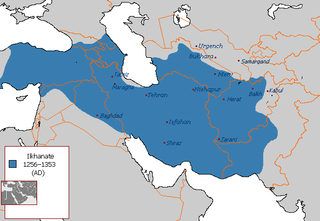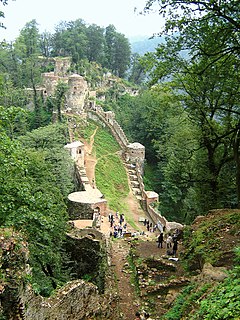 W
WThe history of Syria covers events which occurred on the territory of the present Syrian Arab Republic and events which occurred in the region of Syria. The present Syrian Arab Republic spans territory which was first unified in the 10th century BCE under the Neo-Assyrian Empire, the capital of which was the city of Assur, from which the name "Syria" most likely derives. This territory was then conquered by various rulers, and settled in by different peoples. Syria is considered to have emerged as an independent country for the first time on 24 October 1945, upon the signing of the United Nations Charter by the Syrian government, effectively ending France’s mandate by the League of Nations to "render administrative advice and assistance to the population" of Syria, which came in effect on April 1946. On 21 February 1958, however, Syria merged with Egypt to create the United Arab Republic after plebiscitary ratification of the merger by both countries’ nations, but seceded from it in 1961, thereby recovering its full independence. Since 1963, the Syrian Arab Republic has been ruled by the Ba’ath Party, run by the Assad family exclusively since 1970. Currently Syria is fractured between rival forces due to the Syrian Civil War.
 W
WThe Ayyubid dynasty was a Sunni Muslim dynasty of Kurdish origin, founded by Saladin and centered in Egypt, ruling over the Levant, Mesopotamia, Hijaz, Nubia and parts of the Maghreb. The dynasty ruled large parts of the Middle East during the 12th and 13th centuries. Saladin had risen to vizier of Fatimid Egypt in 1169, before abolishing the Fatimid Caliphate in 1171. Three years later, he was proclaimed sultan following the death of his former master, the Zengid ruler Nur al-Din and established himself as the first custodian of the two holy mosques. For the next decade, the Ayyubids launched conquests throughout the region and by 1183, their domains encompassed Egypt, Syria, Upper Mesopotamia, the Hejaz, Yemen and the North African coast up to the borders of modern-day Tunisia. Most of the Crusader states including the Kingdom of Jerusalem fell to Saladin after his victory at the Battle of Hattin in 1187. However, the Crusaders regained control of Palestine's coastline in the 1190s.
 W
WThe Banu Ghani was an Arab tribe that inhabited the area between Bisha and Diriyah in pre-Islamic Arabia and parts of which migrated to Syria during the Muslim conquest of that region.
 W
WThe Banū Munqidh, also referred to as the Munqidhites, were an Arab family that ruled an emirate in the Orontes Valley in northern Syria from the mid-11th century until the family's demise in an earthquake in 1157. The emirate was initially based in Kafartab before the Banu Munqidh took over the fortress of Shayzar in 1081 and made it their headquarters for the remainder of their rule. The capture of Shayzar was the culmination of a long, drawn out process beginning with the Banu Munqidh's nominal assignment to the land by the Mirdasid emir of Aleppo in 1025, and accelerating with the weakened grip of Byzantine rule in northern Syria in the 1070s.
 W
WThe County of Edessa was one of the Crusader states in the 12th century. Its seat was the city of Edessa.
 W
WGökböri, or Muzaffar ad-Din Gökböri, was a leading emir and general of Sultan Saladin, and ruler of Erbil. He served both the Zengid and Ayyubid rulers of Syria and Egypt. He played a pivotal role in Saladin's conquest of Northern Syria and the Jazira and later held major commands in a number of battles against the Crusader states and the forces of the Third Crusade. He was known as Manafaradin to the Franks of the Crusader states.
 W
WThe Ilkhanate, also spelled Il-khanate, known to the Mongols as Hülegü Ulus was a khanate established from the southwestern sector of the Mongol Empire, ruled by the Mongol House of Hulagu. Hulagu Khan, the son of Tolui and grandson of Genghis Khan, inherited the Middle Eastern part of the Mongol Empire after his brother Möngke Khan died in 1260. Its core territory lies in what is now part of the countries of Iran, Azerbaijan, and Turkey. At its greatest extent, the Ilkhanate also included parts of modern Iraq, Armenia, Georgia, Afghanistan, Turkmenistan, Pakistan, part of modern Dagestan, and part of modern Tajikistan. Later Ilkhanate rulers, beginning with Ghazan in 1295, converted to Islam. In the 1330s, the Ilkhanate was ravaged by the Black Death. Its last khan Abu Sa'id died in 1335, after which the khanate disintegrated.
 W
WThe Jarrahids were an Arab dynasty that intermittently ruled Palestine and controlled Transjordan and northern Arabia in the late 10th and early 11th centuries. They were described by historian Marius Canard (1888–1982) as a significant player in the Byzantine–Fatimid wars in Syria who "created for themselves, in their own best interests, a rule of duplicity, treason and pillage". They were the ruling family of the Tayy tribe, one of the three powerful tribes of Syria at the time; the other two were Kalb and Kilab.
 W
WThe Judham was an Arab tribe that inhabited the southern Levant and northwestern Arabia during the Byzantine and early Islamic eras. Under the Byzantines, the tribe was nominally Christian and fought against the Muslim army between 629 and 636, until the Byzantines and their Arab allies were defeated at the Battle of Yarmouk. Afterward, the Judham converted to Islam and became the largest tribal faction of Jund Filastin.
 W
WThe Mamluk Sultanate was a medieval realm spanning Egypt, the Levant and Hejaz that established itself as a caliphate. It lasted from the overthrow of the Ayyubid dynasty until the Ottoman conquest of Egypt in 1517. Historians have traditionally broken the era of Mamlūk rule into two periods—one covering 1250–1382, the other, 1382–1517. Western historians call the former the "Baḥrī" period and the latter the "Burjī" due to the political dominance of the regimes known by these names during the respective eras. Contemporary Muslim historians refer to the same divisions as the "Turkic" and "Circassian" periods in order to stress the change in the ethnic origins of the majority of Mamlūks.
 W
WThe Nizari state was a Shia Nizari Ismaili state founded by Hassan-i Sabbah after he took control of the Alamut Castle in 1090 AD, which marked the beginning of an era of Ismailism known as the Alamut period. Their people were also known as the Assassins.
 W
WNur al-Din Bimaristan is a large Muslim medieval bimaristan ("hospital") in Damascus, Syria. It is located in the al-Hariqa quarter in the old walled city, to the southwest of the Umayyad Mosque. It was built and named after the Zengid Sultan Nur ad-Din in 1154, and later on an extension was added to the main building in 1242 by a physician Badr al-Din. It was restored in 1975 and now houses the Museum of Medicine and Science in the Arab World.
 W
WThe Assassins were a Nizari Isma'ili sect who lived in the mountains of Persia and in Syria between 1090 and 1275. During that time, they held a strict subterfuge policy throughout the Middle East through the covert murder of first Muslim and later Christian leaders that were considered enemies of their state. The modern term assassination is based on the tactics used by the Assassins. Nizari Isma'ilism formed in the late 11th century after a succession crisis within the Fatimid Caliphate between Nizar ibn al-Mustansir and his half-brother, caliph al-Musta'li. Contemporaneous historians include Arabs ibn al-Qalanisi and Ali ibn al-Athir and the Persian Ata-Malik Juvayni. The first two referred to the Assassins as batiniyya, an epithet widely accepted by Isma'ilis themselves.
 W
WThe Rashidun Caliphate was the first of the four major caliphates established after the death of the Islamic prophet Muhammad. It was ruled by the first five successive caliphs (successors) of Muhammad after his death in 632 CE. These caliphs are collectively known in Sunni Islam as the Rashidun, or "Rightly Guided" caliphs. This term is not widely used in Shia Islam as Shia Muslims do not consider the rule of the first three caliphs as legitimate.
 W
WThe Great Seljuq Empire or the Seljuk Empire was a high medieval Turko-Persian Sunni Muslim empire, originating from the Qiniq branch of Oghuz Turks. At its greatest extent, the Seljuk Empire controlled a vast area stretching from western Anatolia and the Levant to the Hindu Kush in the east, and from Central Asia to the Persian Gulf in the south.
 W
WThe Timurid Empire, self-designated as Gurkani, was a Persianate Turco-Mongol empire comprising modern-day Uzbekistan, Iran, the southern Caucasus, Mesopotamia, Afghanistan, much of Central Asia, as well as parts of contemporary India, Pakistan, Syria and Turkey.
 W
WThe Umayyad Caliphate was the second of the four major caliphates established after the death of Muhammad. The caliphate was ruled by the Umayyad dynasty. The third caliph of Rashidun Caliphate, Uthman ibn Affan, was also a member of the Umayyad clan. The family established dynastic, hereditary rule with Muawiya ibn Abi Sufyan, long-time governor of al-Sham, who became the sixth caliph after the end of the First Muslim Civil War in 661. After Mu'awiyah's death in 680, conflicts over the succession resulted in a Second Civil War and power eventually fell into the hands of Marwan I from another branch of the clan. The region of Syria remained the Umayyads' main power base thereafter, and Damascus was their capital.
 W
WThe Zengid or Zangid dynasty was a Muslim dynasty of Oghuz Turk origin, which ruled parts of the Levant and Upper Mesopotamia on behalf of the Seljuk Empire. The dynasty was founded by Imad ad-Din Zengi.